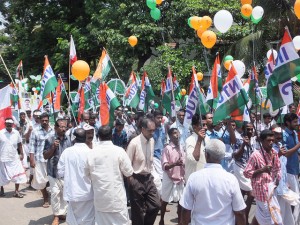The BJP’s victory, as expected, was comprehensive. The sheer scale of that victory was underestimated, perhaps, and the defeat of Congress and her allies puts the Hindu party and other members of the National Democratic Alliance (NDA) in a position of unassailable strength. As India’s 7th decade draws near, Narendra Modi has the opportunity to be a fulcrum, placing her back on the map as a political power.
The fears raked up by the Western media and Congress party that Hindu fanatics would cut down Muslims and other minorities has failed to materialise, and the internal strength of India looks set to grow rather than collapse in the future. Nevertheless, there are worrying signs from members of the government that more hard-line views have not disappeared entirely. Health Minister Harsh Vardhan commented that Western sex education should be banned, and questioned the use of condoms in fighting HIV. In a nation where strong sentiments surrounding ‘Western corruption’ are easily whipped up by politicians seeking the mandate for backwards decisions, this is a troubling note, if still one which has received backlash from within India. Discourse surrounding celibacy often play into the bizarre Madonna-whore complex which prevails across India, creating an atmosphere of misogyny which allows so much damage to be done to the female populace. How far Modi will have to pander to the conservative groups is questionable, but in India – a nation where police can be bribed, talked around, or simply overwhelmed by numbers – unofficial groups remain a persistent threat. It is telling that village militias are fighting Naxalite (Communist) rebels in order to supplement police forces.
Modi’s first moves on the international stage have proven interesting, with the various leaders of the ASEAN nations attending his inauguration. India’s long-lapsed position as a major regional power has not been returned through this alone, but it has certainly shown a contrast to the previous government’s position. The release of fishermen by both Pakistan and Sri Lanka – actions with limited precedent in recent times – suggests that their governments, neither who have great love for India, feel that Modi is less of a push-over than the Gandhi regime. Whilst Pakistani Prime Minister Nawaz Sharif has offered to make moves on the constantly delayed peace process, the recent attack on Karachi Airport demonstrates the power that Islamist groups exert over India’s neighbour. The continuing return of bodies of jawans, infantrymen, from the Indian side of the Line of Control in Kargil, offers another potential obstacle to a return to normality.
Economically, a return to strength may well prove even more difficult. The upcoming loss of Carrefour reveals an almost atavistic idea of self-sufficiency. Trading on the Mahatma’s idea of swadeshi, self-sufficiency, the barring of most multinational corporations may well frighten foreign investors and threatens to remove India from the BRIC. At the same time, in addition to a boost in popularity amongst its more conservative supporters, India truly has an opportunity to advance national business. More optimistic ideals for a growth in family-run corner shops is unlikely to materialise, however, as major retailers like Reliance look set to continue their strangle-hold over the retail sector. Reliance’s chairman, Mukesh Ambani, came under fire from the protest party, the Aam Aadmi Party (AAP), during the election – they alleged that through deals with the government surrounding the rights to natural gas, Reliance was given a favourable rate to the considerable detriment of the public.
Rumours about Reliance’s move into the production of civil and military aircraft, however, will be welcome news in many quarters. India’s military equipment programme has been wrecked by scandals, often as a result of procurement from foreign companies. The Agusta-Westland scandal was received with considerable acrimony for its termination of British jobs, but the history of corrupt middlemen supplying faulty or over-priced equipment has been a hallmark of previous governments. India’s own weapons programmes have proven seriously backwards to boot. The INSAS rifle, the workhorse of the infantry, is up for replacement. Discarded at times in favour of AK47s used by the enemy or informally procured, the new weapons programme may well take years to fully implement. Despite Modi’s triumphal induction of INS Vikramaditya into the navy, the shadow of the sinking of the INS Sindhurakshak last year remains heavy. Docked in Mumbai, still unexplained explosions on the 14th of August, the night before Indian Independence Day, saw the submarine sink in the crowded harbour, killing 18 crewmen. Although the exact cause remains to be found, faulty equipment seems as likely a reason as the “inadvertent mishandling of ammunition” stated by the official report. If India is to draw in a new era of regional power, it is going to need an army which can stand its ground and equipment which will not let it down.
India stands at the cross-roads of history and it must decide if it will advance or fall. There are varied paths down which it can fall – collapsing into the corrupt state which it already half-resembles, and which Pakistan has perfected. Alternatively, the threat of Hindu fundamentalism lingers at the margins, in the villages and towns where the rule of law is less stringent – it is not impossible that it could push itself into the forefront of politics. If Narendra Modi can steer the state on a path which offers prosperity for all, galvanises a poorly-tuned workforce, and shows neighbours and distant powers alike that India will no longer take their slights without a whimper, he may just leave a grand legacy for the largest democracy in the world.




